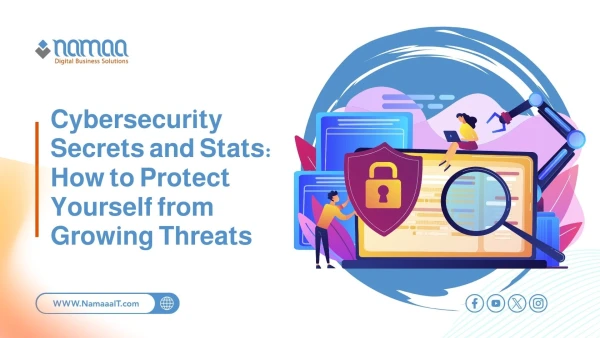Cybersecurity has become a fundamental field for protecting information and systems from digital threats. It began in the 1970s with the emergence of computer networks and has continuously evolved with the expansion of the internet and the increasing reliance of organizations on digital infrastructure.
Cybersecurity plays a vital role in safeguarding sensitive data, ensuring business continuity, and protecting the reputation of organizations from attacks that could compromise their systems. It has also become a highly significant field in the job market due to the growing need for specialists capable of tackling modern and sophisticated threats.
This article will cover the definition and history of cybersecurity, its importance, how to specialize in it, and the key tools used in the field.
What is Cybersecurity?
Cybersecurity refers to the set of practices, policies, and technologies aimed at protecting systems, networks, and data from digital attacks and breaches. It encompasses all aspects of digital protection, including securing networks, servers, devices, software, and personal or sensitive data. This field is one of the foundational pillars of the technology world, focusing on maintaining the confidentiality, integrity, and availability of information. Cybersecurity involves various measures such as antivirus programs, encryption, firewalls, and identity verification to secure data from potential threats. With the advancement of technology and the constant evolution of attack methods, cybersecurity has become indispensable for protecting individuals, businesses, and governments from digital attacks.
Cyber threats are increasing rapidly, as hackers and attackers seek to exploit security vulnerabilities for various purposes, including theft, manipulation, or system disruption. Although cybersecurity may seem complex to some, its primary goal is to protect digital assets and personal information. With the growing reliance on the internet and digital systems in daily life, cybersecurity has become a critical area of concern across all sectors globally.
The Historical Development of Cybersecurity
Cybersecurity's history dates back to the early use of computer networks in the 1970s, when the focus was on protecting systems from initial attacks. During that period, cybersecurity primarily aimed to maintain network stability and prevent unauthorized system access. In the early 1980s, the field saw significant improvements with the development of antivirus programs as key tools to counter digital threats.
With the rapid expansion of the internet in the 1990s, cybersecurity shifted from being a local issue to a global concern. The volume and diversity of digital attacks grew, prompting governments and businesses to develop more advanced strategies and technologies to keep up with increasing threats. This era saw the emergence of firewalls, advanced antivirus programs, and digital forensics to understand how attacks occurred.
In the past two decades, with advancements in digital technologies and artificial intelligence, cybersecurity has faced new challenges. Cyberattacks have become more complex, with the emergence of ransomware and large-scale hacking. Data has become a vital part of business operations and cloud storage, making data protection a top priority. Today, the field continues to expand, with a growing demand for cybersecurity professionals to keep up with innovations and developments in cyberattack methods.
The Importance of Cybersecurity in Protecting Personal Information
Cybersecurity is essential for protecting personal information from digital threats. As our daily transactions increasingly occur online, our personal data becomes vulnerable to breaches and attacks that can result in identity theft or manipulation. This includes sensitive details such as banking information, health records, mobile data, and passwords, which are prime targets for hackers. Without adequate protection, this information can be stolen or exploited by untrusted entities.
Cybersecurity practices such as complex passwords, two-factor authentication, and encryption help ensure the confidentiality and safety of personal data. For instance, encryption is a vital technique that secures data during transmission, making it readable only by the sender and recipient. Additionally, using antivirus software and regularly updating operating systems are crucial steps in protecting against malware that could compromise personal security.
With the rise in cyberattacks and new hacking methods, raising public awareness about cybersecurity and providing tools and resources to help individuals protect their personal data effectively is more important than ever. Ultimately, cybersecurity serves as the first line of defense against anything that threatens individual privacy.
read more: AI Applications in Operations Management
The Role of Cybersecurity in Protecting Organizations and Businesses
Cybersecurity is the cornerstone of protecting organizations and businesses from digital threats that can significantly impact their operations and reputation. As companies rely on digital systems to store data and carry out daily operations, securing these systems is critical. Cyberattacks can disrupt operations, lead to the loss of sensitive data, or even exploit financial information for illicit gain. By implementing appropriate cybersecurity strategies, organizations can minimize the risks associated with these threats and safeguard their digital infrastructure.
Key technologies for protecting organizations include firewalls, intrusion detection systems, and data encryption tools. These technologies help prevent attacks before they reach critical systems and monitor data traffic within networks to detect unauthorized activities. Moreover, continuous training of employees on security best practices is crucial in reducing the chances of breaches caused by human error.
Although organizations may be equipped with advanced tools and technologies, modern attacks are increasingly sophisticated and require proactive strategies to effectively protect sensitive data. Therefore, companies must adopt regularly updated cybersecurity policies and conduct frequent risk assessments to ensure comprehensive protection against ongoing threats.
Learn more: ERP System Integration with E-commerce
Common Types of Cyber Threats and How They Work
Cyber threats have become one of the greatest risks facing both individuals and organizations. These threats are growing more complex as attackers attempt to infiltrate digital systems to steal information, disrupt activities, or cause financial harm. Below is an overview of common cyber threats, how they operate, and how to prevent them.
Viruses
Viruses are malicious programs designed to infiltrate computers or systems and destroy data or disrupt operations. They usually attach themselves to legitimate files or programs and spread to other systems when these files are opened. Viruses can cause data loss, file destruction, or make systems inoperable.
They typically spread through email attachments or suspicious software downloads. Once activated, a virus begins replicating and infecting other files on the system or network. Because they can cause severe damage, using and regularly updating antivirus software is essential.
Worms
Worms are similar to viruses but differ in operation. While viruses require human interaction to spread—such as opening a file or running a program—worms can automatically propagate through networks without user involvement. They exploit security flaws in operating systems or applications to move from one device to another.
Worms can slow down or completely disable networks, steal data, or use infected systems to launch other attacks like Distributed Denial of Service (DDoS). Preventing worms requires regular security updates and patching system vulnerabilities.
Malware
Malware is a general term encompassing various malicious software types designed to harm computer systems or networks. It includes viruses, worms, Trojans, ransomware, and more. Malware is intended to steal data, disrupt systems, or destroy information.

.webp)







